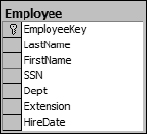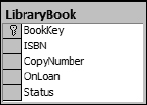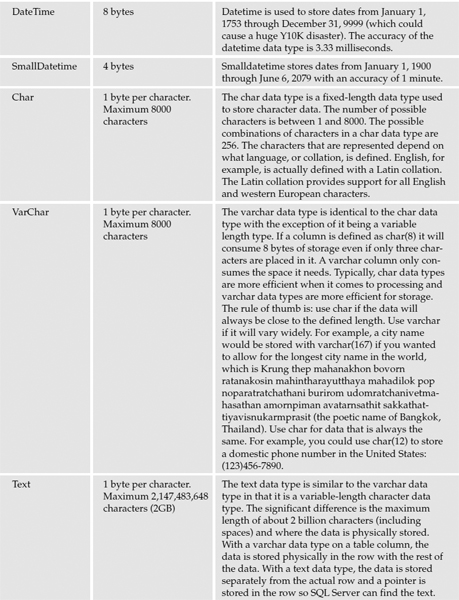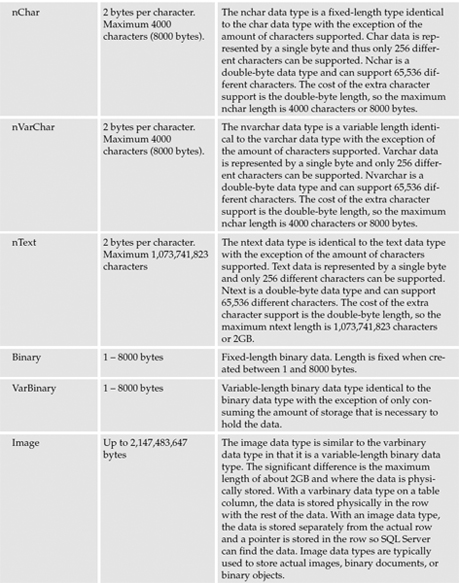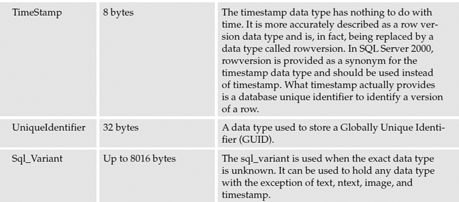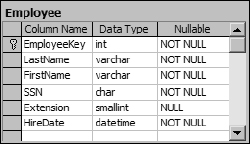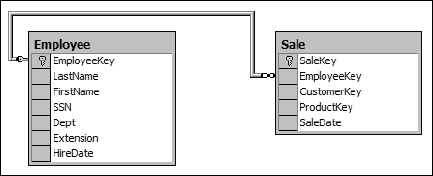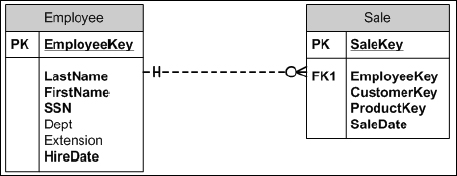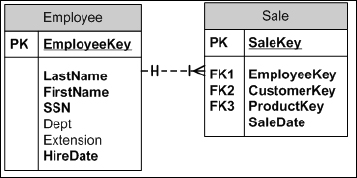1
Introducing Transact-SQL and Data Management Systems
Welcome to the world of Transact-Structured Query Language programming. Transact-SQL, or T-SQL, is Microsoft Corporation's implementation of the Structured Query Language, which was designed to retrieve, manipulate, and add data to Relational Database Management Systems (RDBMS). Hopefully, you already have a basic idea of what SQL is used for because you purchased this book, but you may not have a good understanding of the concepts behind relational databases and the purpose of SQL. This first chapter introduces you to some of the fundamentals of the design and architecture of relational databases and presents a brief description of SQL as a language. If you are brand new to SQL and database technologies, this chapter will provide a foundation to help ensure the rest of the book is as effective as possible. If you are already comfortable with the concepts of relational databases and Microsoft's implementation, specifically, you may want to skip on ahead to Chapter 2, “SQL Server Fundamentals,” or Chapter 3, “Tools for Accessing SQL Server.” Both of these chapters introduce some of the features and tools in SQL Server 2000 as well as the new features and tools coming with SQL Server 2005.
Another great, more in-depth source for SQL 2000 and SQL 2005 programming from the application developer's perspective are the Wrox Press books authored by Rob Viera: Professional SQL Server 2000 Programming, Beginning SQL Server 2005 Programming, and Professional SQL Server 2005 Programming. Throughout the chapters ahead, I will refer back to both the basic concepts introduced in this chapter and to areas in the books mentioned here for further clarification in the use or nature of the Transact-SQL language.
Transact-Structured Query Language
T-SQL is Microsoft's implementation of a standard established by the American National Standards Institute (ANSI) for the Structured Query Language (SQL). SQL was first developed by researchers at IBM. They called their first pre-release version of SQL “SEQUEL,” which stood for Structured English QUEry Language. The first release version was renamed to SQL, dropping the English part but retaining the pronunciation to identify it with its predecessor. Today, several implementations of SQL by different stakeholders are in the database marketplace, and as you sojourn through the sometimes-mystifying lands of database technology you will undoubtedly encounter these different varieties of SQL. What makes them all similar is the ANSI standard to which IBM, more than any other vendor, adheres to with tenacious rigidity. However, what differentiate the many implementations of SQL are the customized programming objects and extensions to the language that make it unique to that particular platform. Microsoft SQL Server 2000 implements ANSI-92, or the 1992 standard as set by ANSI. SQL Server 2005 implements ANSI-99. The term “implements” is of significance. T-SQL is not fully compliant with ANSI standards in its 2000 or 2005 implementation; neither is Oracle's P/L SQL, Sybase's SQLAnywhere, or the open-source MySQL. Each implementation has custom extensions and variations that deviate from the established standard. ANSI has three levels of compliance: Entry, Intermediate, and Full. T-SQL is certified at the entry level of ANSI compliance. If you strictly adhere to the features that are ANSI-compliant, the same code you write for Microsoft SQL Server should work on any ANSI-compliant platform; that's the theory, anyway. If you find that you are writing cross-platform queries, you will most certainly need to take extra care to ensure that the syntax is perfectly suited for all the platforms it affects. Really, the simple reality of this issue is that very few people will need to write queries to work on multiple database platforms. These standards serve as a guideline to help keep query languages focused on working with data, rather than other forms of programming, perhaps slowing the evolution of relational databases just enough to keep us sane.
T-SQL: Programming Language or Query Language?
T-SQL was not really developed to be a full-fledged programming language. Over the years the ANSI standard has been expanded to incorporate more and more procedural language elements, but it still lacks the power and flexibility of a true programming language. Antoine, a talented programmer and friend of mine, refers to SQL as “Visual Basic on Quaaludes.” I share this bit of information not because I agree with it, but because I think it is funny. I also think it is indicative of many application developers' view of this versatile language.
The Structured Query Language was designed with the exclusive purpose of data retrieval and data manipulation. Microsoft's T-SQL implementation of SQL was specifically designed for use in Microsoft's Relational Database Management System (RDBMS), SQL Server. Although T-SQL, like its ANSI sibling, can be used for many programming-like operations, its effectiveness at these tasks varies from excellent to abysmal. That being said, I am still more than happy to call T-SQL a programming language if only to avoid someone calling me a SQL “Queryer” instead of a SQL Programmer. However, the undeniable fact still remains; as a programming language, T-SQL falls short. The good news is that as a data retrieval and set manipulation language it is exceptional. When T-SQL programmers try to use T-SQL like a programming language they invariably run afoul of the best practices that ensure the efficient processing and execution of the code. Because T-SQL is at its best when manipulating sets of data, try to keep that fact foremost in your thoughts during the process of developing T-SQL code.
Performing multiple recursive row operations or complex mathematical computations is quite possible with T-SQL, but so is writing a .NET application with Notepad. Antoine was fond of responding to these discussions with, “Yes, you can do that. You can also crawl around the Pentagon on your hands and knees if you want to.” His sentiments were the same as my father's when I was growing up; he used to make a point of telling me that “Just because you can do something doesn't mean you should.” The point here is that oftentimes SQL programmers will resort to creating custom objects in their code that are inefficient as far as memory and CPU consumption are concerned. They do this because it is the easiest and quickest way to finish the code. I agree that there are times when a quick solution is the best, but future performance must always be taken into account. This book tries to show you the best way to write T-SQL so that you can avoid writing code that will bring your server to its knees, begging for mercy.
What's New in SQL Server 2005
Several books and hundreds of web sites have already been published that are devoted to the topic of “What's New in SQL Server 2005,” so I won't spend a great deal of time describing all the changes that come with this new release. Instead, throughout the book I will identify those changes that are applicable to the subject being described. However, in this introductory chapter I want to spend a little time discussing one of the most significant changes and how it will impact the SQL programmer. This change is the incorporation of the .NET Framework with SQL Server.
T-SQL and the .NET Framework
The integration of SQL Server with Microsoft's .NET Framework is an awesome leap forward in database programming possibilities. It is also a significant source of misunderstanding and trepidation, especially by traditional infrastructure database administrators.
This new feature, among other things, allows developers to use programming languages to write stored procedures and functions that access and manipulate data with object-oriented code, rather than SQL statements.
Kiss T-SQL Goodbye?
Any reports of T-SQL's demise are premature and highly exaggerated. The ability to create database programming objects in managed code instead of SQL does not mean that T-SQL is in danger of becoming extinct. A marketing-minded executive at one of Microsoft's partner companies came up with a cool tagline about SQL Server 2005 and the .NET Framework that said “SQL Server 2005 and .NET; Kiss SQL Good-bye.” He was quickly dissuaded by his team when presented with the facts. However, the executive wasn't completely wrong. What his catchy tagline could say and be accurate is “SQL Server 2005 and .NET; Kiss SQL Cursors Good-bye.” It could also have said the same thing about complex T-SQL aggregations or a number of T-SQL solutions presently used that will quickly become obsolete with the release of SQL Server 2005.
Transact-SQL cursors are covered in detail in Chapter 10, so for the time being, suffice it to say that they are generally a bad thing and should be avoided. Cursors are all about recursive operations with single or row values. They consume a disproportionate amount of memory and CPU resources compared to set operations.
With the integration of the .NET Framework and SQL Server, expensive cursor operations can be replaced by efficient, compiled assemblies, but that is just the beginning. A whole book could be written about the possibilities created with SQL Server's direct access to the .NET Framework. Complex data types, custom aggregations, powerful functions, and even managed code triggers can be added to a database to exponentially increase the flexibility and power of the database application. Among other things, one of the chief advantages of the .NET Framework's integration is the ability of T-SQL developers to have complete access to the entire .NET object model and operating system application programming interface (API) library without the use of custom extended stored procedures. Extended stored procedures and especially custom extended stored procedures, which are almost always implemented through unmanaged code, have typically been the source of a majority of the security and reliability issues involving SQL Server. By replacing extended stored procedures, which can only exist at the server level, with managed assemblies that exist at the database level, all kinds of security and scalability issues virtually disappear.
Database Management System (DBMS)
A DBMS is a set of programs that are designed to store and maintain data. The role of the DBMS is to manage the data so that the consistency and integrity of the data is maintained above all else. Quite a few types and implementations of Database Management Systems exist:
- Hierarchical Database Management Systems (HDBMS)—Hierarchical databases have been around for a long time and are perhaps the oldest of all databases. It was (and in some cases still is) used to manage hierarchical data. It has several limitations such as only being able to manage single trees of hierarchical data and the inability to efficiently prevent erroneous and duplicate data. HDBMS implementations are getting increasingly rare and are constrained to specialized, and typically, non-commercial applications.
- Network Database Management System (NDBMS)—The NDBMS has been largely abandoned. In the past, large organizational database systems were implemented as network or hierarchical systems. The network systems did not suffer from the data inconsistencies of the hierarchical model but they did suffer from a very complex and rigid structure that made changes to the database or its hosted applications very difficult.
- Relational Database Management System (RDBMS)—An RDBMS is a software application used to store data in multiple related tables using SQL as the tool for creating, managing, and modifying both the data and the data structures. An RDBMS maintains data by storing it in tables that represent single entities and storing information about the relationship of these tables to each other in yet more tables. The concept of a relational database was first described by E.F. Codd, an IBM scientist who defined the relational model in 1970. Relational databases are optimized for recording transactions and the resultant transactional data. Most commercial software applications use an RDBMS as their data store. Because SQL was designed specifically for use with an RDBMS, I will spend a little extra time covering the basic structures of an RDBMS later in this chapter.
- Object-Oriented Database Management System (ODBMS)—The ODBMS emerged a few years ago as a system where data was stored as objects in a database. ODBMS supports multiple classes of objects and inheritance of classes along with other aspects of object orientation. Currently, no international standard exists that specifies exactly what an ODBMS is and what it isn't. Because ODBMS applications store objects instead of related entities, it makes the system very efficient when dealing with complex data objects and object-oriented programming (OOP) languages such as the new .NET languages from Microsoft as well as C and Java. When ODBMS solutions were first released they were quickly touted as the ultimate database system and predicted to make all other database systems obsolete. However, they never achieved the wide acceptance that was predicted. They do have a very valid position in the database market, but it is a niche market held mostly within the Computer-Aided Design (CAD) and telecommunications industries.
- Object-Relational Database Management System (ORDBMS)—The ORDBMS emerged from existing RDBMS solutions when the vendors who produced the relational systems realized that the ability to store objects was becoming more important. They incorporated mechanisms to be able to store classes and objects in the relational model. ORDBMS implementations have, for the most part, usurped the market that the ODBMS vendors were targeting for a variety of reasons that I won't expound on here. However, Microsoft's SQL Server 2005, with its XML data type and incorporation of the .NET Framework, could arguably be labeled an ORDBMS.
SQL Server as a Relational Database Management System
This section introduces you to the concepts behind relational databases and how they are implemented from a Microsoft viewpoint. This will, by necessity, skirt the edges of database object creation, which is covered in great detail in Chapter 11, so for the purpose of this discussion I will avoid the exact mechanics and focus on the final results.
As I mentioned earlier, a relational database stores all of its data inside tables. Ideally, each table will represent a single entity or object. You would not want to create one table that contained data about both dogs and cars. That isn't to say you couldn't do this, but it wouldn't be very efficient or easy to maintain if you did.
Tables
Tables are divided up into rows and columns. Each row must be able to stand on its own, without a dependency to other rows in the table. The row must represent a single, complete instance of the entity the table was created to represent. Each column in the row contains specific attributes that help define the instance. This may sound a bit complex, but it is actually very simple. To help illustrate, consider a real-world entity, an employee. If you want to store data about an employee you would need to create a table that has the properties you need to record data about your employee. For simplicity's sake, call your table Employee.
For more information on naming objects, check out the “Naming Conventions” section in Chapter 4.
When you create your employee table you also need to decide on what attributes of the employee you want to store. For the purposes of this example you have decided to store the employee's last name, first name, social security number, department, extension, and hire date. The resulting table would look something like that shown in Figure 1-1.
Figure 1-1
The data in the table would look something like that shown in Figure 1-2.
Figure 1-2
Primary Keys
To efficiently manage the data in your table you need to be able to uniquely identify each individual row in the table. It is much more difficult to retrieve, update, or delete a single row if there is not a single attribute that identifies each row individually. In many cases, this identifier is not a descriptive attribute of the entity. For example, the logical choice to uniquely identify your employee is the social security number attribute. However, there are a couple of reasons why you would not want to use the social security number as the primary mechanism for identifying each instance of an employee. So instead of using the social security number you will assign a non-descriptive key to each row. The key value used to uniquely identify individual rows in a table is called a primary key.
The reasons you choose not to use the social security number as your primary key column boil down to two different areas: security and efficiency.
When it comes to security, what you want to avoid is the necessity of securing the employee's social security number in multiple tables. Because you will most likely be using the key column in multiple tables to form your relationships (more on that in a moment), it makes sense to substitute a non-descriptive key. In this way you avoid the issue of duplicating private or sensitive data in multiple locations to provide the mechanism to form relationships between tables.
As far as efficiency is concerned, you can often substitute a non-data key that has a more efficient or smaller data type associated with it. For example, in your design you might have created the social security number with either a character data type or an integer. If you have fewer than 32,767 employees, you can use a double byte integer instead of a 4-byte integer or 10-byte character type; besides, integers process faster than characters.
You will still want to ensure that every social security number in your table is unique and not NULL, but you will use a different method to guarantee this behavior without making it a primary key.
A non-descriptive key doesn't represent anything else with the exception of being a value that uniquely identifies each row or individual instance of the entity in a table. This will simplify the joining of this table to other tables and provide the basis for a “Relation.” In this example you will simply alter the table by adding an EmployeeKey column that will uniquely identify every row in the table, as shown in Figure 1-3.
Figure 1-3
With the EmployeeKey column, you have an efficient, easy-to-manage primary key.
Each table can have only one primary key, which means that this key column is the primary method for uniquely identifying individual rows. It doesn't have to be the only mechanism for uniquely identifying individual rows; it is just the “primary” mechanism for doing so. Primary keys can never be NULL and they must be unique. I am a firm believer that primary keys should almost always be single-column keys, but this is not a requirement. Primary keys can also be combinations of columns. If you have a table where two columns in combination are unique, while either single column is not, you can combine the two columns as a single primary key, as illustrated in Figure 1-4.
Figure 1-4
In this example the LibraryBook table is used to maintain a record of every book in the library. Because multiple copies of each book can exist, the ISBN column is not useful for uniquely identifying each book. To enable the identification of each individual book the table designer decided to combine the ISBN column with the copy number of each book. I personally avoid the practice of using multiple column keys. I prefer to create a separate column that can uniquely identify the row. This makes it much easier to write JOIN queries (covered in great detail in Chapter 5). The resulting code is cleaner and the queries are generally more efficient. For the library book example, a more efficient mechanism might be to assign each book its own number. The resulting table would look like that shown in Figure 1-5.
Figure 1-5
A table is a set of rows and columns used to represent an entity. Each row represents an instance of the entity. Each column in the row will contain at most one value that represents an attribute, or property, of the entity. Take the employee table; each row represents a single instance of the employee entity. Each employee can have one and only one first name, last name, SSN, extension, or hire date according to your design specifications. In addition to deciding what attributes you want to maintain, you must also decide how to store those attributes. When you define columns for your tables you must, at a minimum, define three things:
- The name of the column
- The data type of the column
- Whether or not the column can support NULL
Column Names
Keep the names simple and intuitive. For more information see Chapter 11.
Data Types
The general rule on data types is to use the smallest one you can. This conserves memory usage and disk space. Also keep in mind that SQL Server processes numbers much more efficiently than characters, so use numbers whenever practical. I have heard the argument that numbers should only be used if you plan on performing mathematical operations on the columns that contain them, but that just doesn't wash. Numbers are preferred over string data for sorting and comparison as well as mathematical computations. The exception to this rule is if the string of numbers you want to use starts with a zero. Take the social security number, for example. Other than the unfortunate fact that some social security numbers (like my daughter's) begin with a zero, the social security number would be a perfect candidate for using an integer instead of a character string. However, if you tried to store the integer 012345678 you would end up with 12345678. These two values may be numeric equivalents but the government doesn't see it that way. They are strings of numerical characters and therefore must be stored as characters rather than numbers.
When designing tables and choosing a data type for each column, try to be conservative and use the smallest, most efficient type possible. But, at the same time, carefully consider the exception, however rare, and make sure that the chosen type will always meet these requirements.
The data types available for columns in SQL Server 2000 and 2005 are specified in the following table.
SQL Server supports additional data types that can be used in queries and programming objects, but they are not used to define columns. These data types are listed in the following table.
| Data Type | Description |
| Cursor | The cursor data is used to point to an instance of a cursor. |
| Table | The table data type is used to store an in-memory rowset for processing. It was developed primarily for use with the new table-valued functions introduced in SQL Server 2000. |
SQL Server 2005 Data Types
SQL Server 2005 brings a significant new data type and changes to existing variable data types. New to SQL Server 2005 is the XML data type. The XML data type is a major change to SQL Server. The XML data type allows you to store complete XML documents or well-formed XML fragments in the database. Support for the XML data type includes the ability to create and register an XML schema and then bind the schema to an XML column in a table. This ensures that any XML data stored in that column will adhere to the schema. The XML data type essentially allows the storage and management of objects, as described by XML, to be stored in the database. The argument can then be made that SQL Server 2005 is really an Object-Relational Database Management System (ORDBMS).
LOBs, BLOBs, and CLOBs!
SQL Server 2005 also introduces changes to three variable data types in the form of the new (max) option that can be used with the varchar, nvarchar, and varbinary data types. The (max) option allows for the storage of character or variable-length binary data in excess of the previous 8000-byte limitation. At first glance, this seems like a redundant option because the image data type is already available to store binary data up to 2GB and the text and ntext types can be used to store character data. The difference is in how the data is treated. The classic text, ntext, and image data types are Large Object (LOB) data types and can't typically be used with parameters. The new variable data types with the (max) option are Large Value Types (LVT) and can be used with parameters just like the smaller sized types. This brings a myriad of opportunities to the developer. Large Value Types can be updated or inserted without the need of special handling through STREAM operations. STREAM operations are implemented through an application programming interface (API) such as OLE DB or ODBC and are used to handle data in the form of a Binary Large Object (BLOB). T-SQL cannot natively handle BLOBs, so it doesn't support the use of BLOBs as T-SQL parameters. SQL Server 2005's new Large Value Types are implemented as a Character Large Object (CLOB) and can be interpreted by the SQL engine.
Nullability
All rows from the same table have the same set of columns. However, not all columns will necessarily have values in them. For example, a new employee is hired, but he has not been assigned an extension yet. In this case, the extension column may not have any data in it. Instead, it may contain NULL, which means the value for that column was not initialized. Note that a NULL value for a string column is different from an empty string. An empty string is defined; a NULL is not. You should always consider a NULL as an unknown value. When you design your tables you need to decide whether or not to allow a NULL condition to exist in your columns. NULLs can be allowed or disallowed on a column-by-column basis, so your employee table design could look like that shown in Figure 1-6.
Figure 1-6
Relationships
Relational databases are all about relations. To manage these relations you use common keys. For example, your employees sell products to customers. This process involves multiple entities:
- The employee
- The product
- The customer
- The sale
To identify which employee sold which product to a customer you need some way to link all the entities together. These links are typically managed through the use of keys, primary keys in the parent table and foreign keys in the child table.
As a practical example you can revisit the employee example. When your employee sells a product, his or her identifying information is added to the Sale table to record who the responsible employee was, as illustrated in Figure 1-7. In this case the Employee table is the parent table and the Sale table is the child table.
Figure 1-7
Because the same employee could sell products to many customers, the relationship between the Employee table and the Sale table is called a one-to-many relationship. The fact that the employee is the unique participant in the relationship makes it the parent table. Relationships are very often parent-child relationships, which means that the record in the parent table must exist before the child record can be added. In the example, because every employee is not required to make a sale, the relationship is more accurately described as a one-to-zero-or-more relationship. In Figure 1-7 this relationship is represented by a key and infinity symbol, which doesn't adequately model the true relationship because you don't know if the EmployeeKey field is nullable. In Figure 1-8, the more traditional and informative “Crows Feet” symbols are used. The relationship symbol in this figure represents a one-to-zero-or-more relationship. Figure 1-9 shows the two tables with a one-to-one-or-more relationship symbol.
Figure 1-8
Figure 1-9
Relationships can be defined as follows:
The many-to-many relationship requires three tables because a many-to-many constraint would be unenforceable. An example of a many-to-many relationship is illustrated in Figure 1-10. The necessity for this relationship is created by the relationships between your entities: In a single sale many products can be sold, but one product can be in many sales. This creates the many-to-many relationship between the Sale table and the Product table. To uniquely identify every product and sale combination, you need to create what is called a linking table. The Order table manages your many-to-many relationship by uniquely tracking every combination of sale and product.
Figure 1-10
These figures are an example of a tool called an Entity Relationship Diagram (ERD). The ERD allows the database designer to conceptualize the database design during planning. Microsoft and several other vendors provide design tools that will automatically build the database and component objects from an ERD.
As an example of a one-to-one relationship, suppose that you want to record more detailed data about a sale, but you do not want to alter the current table. In this case, you could build a table called SaleDetail to store the data. To ensure that the sale can be linked to the detailed data, you create a relationship between the two tables. Because each sale should appear in both the Sale table and the SaleDetail table, you would create a one-to-one relationship instead of a one-to-many, as illustrated in Figures 1-11 and 1-12.
Figure 1-11
Figure 1-12
RDBMS and Data Integrity
The RDBMS is designed to maintain data integrity in a transactional environment. This is accomplished through several mechanisms implemented through database objects. The most prominent of these objects are as follows:
- Locks
- Constraints
- Keys
- Indexes
Before I describe these objects in more detail two other important pieces of the SQL architecture need to be understood: connections and transactions.
Connections
A connection is created anytime a process attaches to SQL Server. The connection is established with defined security and connection properties. These security and connection properties determine what data you have access to and, to a certain degree, how SQL Server will behave during the duration of the query in the context of the query. For example, a connection can specify which database to connect to on the server and how to manage memory resident objects.
Transactions
Transactions are explored in detail in Chapter 8, so for the purposes of this introduction I will keep the explanation brief. In a nutshell, a SQL Server transaction is a collection of dependent data modifications that is controlled so that it completes entirely or not at all. For example, you go to the bank and transfer $100.00 from your savings account to your checking account. This transaction involves two modifications, one to the checking account and the other to the savings account. Each update is dependent on the other. It is very important to you and the bank that the funds are transferred correctly so the modifications are placed together in a transaction. If the update to the checking account fails but the update to the savings account succeeds, you most definitely want the entire transaction to fail. The bank feels the same way if the opposite occurs.
With a basic idea about these two objects, let's proceed to the four mechanisms that ensure integrity and consistency in your data.
Locks
SQL Server uses locks to ensure that multiple users can access data at the same time with the assurance that the data will not be altered while they are reading it. At the same time, the locks are used to ensure that modifications to data can be accomplished without impacting other modifications or reads in progress. SQL Server manages locks on a connection basis, which simply means that locks cannot be held mutually by multiple connections. SQL Server also manages locks on a transaction basis. In the same way that multiple connections cannot share the same lock, neither can transactions. For example, if an application opens a connection to SQL Server and is granted a shared lock on a table, that same application cannot open an additional connection and modify that data. The same is true for transactions. If an application begins a transaction that modifies specific data, that data cannot be modified in any other transaction until the first has completed its work. This is true even if the multiple transactions share the same connection.
SQL Server utilizes six lock types, or more accurately, six resource lock modes:
- Shared
- Update
- Exclusive
- Intent
- Schema
- Bulk Update
Shared, Update, Exclusive, and Intent locks can be applied to rows of tables or indexes, pages (8-kilobyte storage page of an index or table), extents (64-kilobyte collection of 8contiguous index or table pages), tables, or databases. Schema and Bulk Update locks apply to tables.
Shared Locks
Shared locks allow multiple connections and transactions to read the resources they are assigned to. No other connection or transaction is allowed to modify the data as long as the Shared lock is granted. Once an application successfully reads the data the Shared locks are typically released, but this behavior can be modified for special circumstances. Shared locks are compatible with other Shared locks so that many transactions and connections can read the same data without conflict.
Update Locks
Update locks are used by SQL Server to help prevent an event known as a deadlock. Deadlocks are bad. They are mostly caused by poor programming techniques. A deadlock occurs when two processes get into a stand-off over shared resources. Let's return to the banking example: In this hypothetical banking transaction both my wife and I go online to transfer funds from our savings account to our checking account. We somehow manage to execute the transfer operation simultaneously and two separate processes are launched to execute the transfer. When my process accesses the two accounts it is issued Shared locks on the resources. When my wife's process accesses the accounts, it is also granted a Shared lock to the resources. So far, so good, but when our processes try to modify the resources pandemonium ensues. First my wife's process attempts to escalate its lock to Exclusive to make the modifications. At about the same time my process attempts the same escalation. However, our mutual Shared locks prevent either of our processes from escalating to an Exclusive lock. Because neither process is willing to release its Shared lock, a deadlock occurs. SQL Server doesn't particularly care for deadlocks. If one occurs SQL Server will automatically select one of the processes as a victim and kill it. SQL Server selects the process with the least cost associated with it, kills it, rolls back the associated transaction, and notifies the responsible application of the termination by returning error number 1205. If properly captured, this error informs the user that “Transaction ## was deadlocked on x resources with another process and has been chosen as the deadlock victim. Rerun the transaction.” To avoid the deadlock from ever occurring SQL Server will typically use Update locks in place of Shared locks. Only one process can obtain an Update lock, preventing the opposing process from escalating its lock. The bottom line is that if a read is executed for the sole purpose of an update, SQL Server may issue an Update lock instead of a Shared lock to avoid a potential deadlock. This can all be avoided through careful planning and implementation of SQL logic that prevents the deadlock from ever occurring.
Exclusive Locks
SQL Server typically issues Exclusive locks when a modification is executed. To change the value of a field in a row SQL Server grants exclusive access of that row to the calling process. This exclusive access prevents a process from any concurrent transaction or connection from reading, updating, or deleting the data being modified. Exclusive locks are not compatible with any other lock types.
Intent Locks
SQL Server issues Intent locks to prevent a process from any concurrent transaction or connection from placing a more exclusive lock on a resource that contains a locked resource from a separate process. For example, if you execute a transaction that updates a single row in a table, SQL Server grants the transaction an Exclusive lock on the row, but also grants an Intent lock on the table containing the row. This prevents another process from placing an Exclusive lock on the table.
Here is an analogy I often use to explain the Intent lock behavior in SQL programming classes: You check in to room 404 at the SQL Hotel. You now have exclusive use of Room 4 on the fourth floor. No other hotel patron will be allowed access to this room. In addition, no other patron will be allowed to buy out every room in the hotel because you have already been given exclusive control to one of the rooms. You have what amounts to an Intent Exclusive lock on the hotel and an Exclusive lock on Room 404. Intent locks are compatible with any less-exclusive lock, as illustrated in the following table on lock compatibility.
SQL Server and Other Products
Microsoft has plenty of competition in the client/server database world and SQL Server is a relatively young product by comparison. However, it has enjoyed wide acceptance in the industry due to its ease of use and attractive pricing. If our friends at Microsoft know how to do anything exceptionally well, it's taking a product to market so it becomes very mainstream and widely accepted.
Microsoft SQL Server
Here is a short history lesson on Microsoft's SQL Server. SQL Server was originally a Sybase product created for IBM's OS/2 platform. Microsoft Engineers worked with Sybase and IBM but eventually withdrew from the project. Microsoft licensed the Sybase SQL Server code and ported the product to work with Windows NT. It took a couple of years before SQL Server really became a viable product. The SQL Server team went to work to create a brand new database engine using the Sybase code as a model. They eventually rewrote the product from scratch.
When SQL Server 7.0 was released in late 1998, it was a major departure from the previous version, SQL Server 6.5. SQL Server 7.0 contained very little Sybase code with the exception of the core database engine technology, which was still under license from Sybase. SQL Server 2000 was released in 2000 with many useful new features, but was essentially just an incremental upgrade of the 7.0 product. SQL Server 2005, however, is a major upgrade and, some say, the very first completely Microsoft product. Any vestiges of Sybase are long gone. The storage and retrieval engine has been completely rewritten, the .NET Framework has been incorporated, and the product has significantly risen in both power and scalability.
Oracle
Oracle is probably the most recognizable enterprise-class database product in the industry. After IBM's E.F. Codd published his original papers on the fundamental principles of relational data storage and design in 1970, Larry Ellison, founder of Oracle, went to work to build a product to apply those principles. Oracle has had a dominant place in the database market for quite some time with a comprehensive suite of database tools and related solutions. Versions of Oracle run on UNIX, Linux, and Windows Servers.
The query language of Oracle is known as Procedure Language/Structured Query Language (PL/SQL). Indeed, many aspects of PL/SQL resemble a C-like procedural programming language. This is evidenced by syntax such as command-line termination using semicolons. Unlike Transact-SQL, statements are not actually executed until an explicit run command is issued (preceded with a single line containing a period.) PL/SQL is particular about using data types and includes expressions for assigning values to compatible column types.
IBM DB2
This is really where it all began. Relational databases and the SQL language were first conceptualized and then implemented in IBM's research department. Although IBM's database products have been around for a very long time, Oracle (then Relational Software) actually beat them to market. DB2 database professionals perceive the form of SQL used in this product to be purely ANSI SQL and other dialects such as Microsoft's T-SQL and Oracle's PL-SQL to be more proprietary. Although DB2 has a long history of running on System 390 mainframes and the AS/400, it is not just a legacy product. IBM has effectively continued to breathe life into DB2 and it remains a viable database for modern business solutions. DB2 runs on a variety of operating systems today including Windows, UNIX, and Linux.
Informix
This product had been a relatively strong force in the client/server database community, but its popularity waned in the late 1990s. Originally designed for the UNIX platform, Informix is a serious enterprise database. Popularity slipped over the past few years, as many applications built on Informix had to be upgraded to contend with year 2000 compatibility issues. Some organizations moving to other platforms (such as Linux and Windows) have also switched products. The 2001 acquisition of Informix nudged IBM to the top spot over Oracle as they brought existing Informix customers with them. Today, Informix runs on Linux and integrates with other IBM products.
Sybase SQLAnywhere
Sybase has deep roots in the client/server database industry and has a strong product offering. At the enterprise level, Sybase products are deployed on UNIX and Linux platforms and have strong support in Java programming circles. At the mid-scale level, SQLAnywhere runs on several platforms including UNIX, Linux, Mac OS, Netware, and Windows. Sybase has carved a niche for itself in the industry for mobile device applications and related databases.
Microsoft Access
Access was partially created from the ground up but also leverages some of the query technology gleaned from Microsoft's acquisition of FoxPro. As a part of Microsoft's Office Suite, Access is a very convenient tool for creating simple business applications. Although Access SQL is ANSI 92 SQL-compliant, it is quite a bit different from Transact-SQL. For this reason, I have made it a point to identify some of the differences between Access and Transact-SQL throughout the book.
Access has become the non-programmer's application development tool. Many people get started in database design using Access and then move on to SQL Server as their needs become more sophisticated. Access is a powerful tool for the right kinds of applications, and some commercial products have actually been developed using Access. Unfortunately, because Access is designed (and documented) to be an end-user's tool rather than a software developer's tool, many Access databases are often poorly designed and power users learn through painful trial and error about how not to create database applications.
Access was developed right around 1992 and is based on the JET Database Engine. JET is a simple and efficient storage system for small to moderate volumes of data and for relatively few concurrent users, but falls short of the stability and fault-tolerance of SQL Server. For this reason, a desktop version of the SQL Server engine has shipped with Access since Office 2000. The Microsoft SQL Server Desktop Engine (MSDE) is an alternative to using JET and really should be used in place of JET for any serious database. Starting smaller-scale projects with the MSDE provides an easier path for migrating them to full-blown SQL Server later on.
MySQL
MySQL is a developer's tool embraced by the open-source community. Like Linux and Java, it can be obtained free of charge and includes source code. Compilers and components of the database engine can be modified and compiled to run on most any computer platform. Although MySQL supports ANSI SQL, it promotes the use of an application programming interface (API) that wraps SQL statements. As a database product, MySQL is a widely accepted and capable product. However, it appeals more to the open source developer than to the business user.
Many other database products on the market may share some characteristics of the products discussed here. The preceding list represents the most popular database products that use ANSI SQL.
Summary
Microsoft SQL Server 2000 remains a very capable and powerful database management server, but I am more than just a little excited about the upcoming release of SQL Server 2005. SQL Server 2005 takes T-SQL and database management a huge step forward. Having worked with “Yukon” since its first beta release, I have witnessed the emergence of a world-class database management system that will undoubtedly strike fear in the heart of its competitors.
The coming chapters explore all the longstanding features and capabilities of T-SQL and preview some of the awesome new capabilities that SQL Server 2005 brings to the field of T-SQL programming. So sit back and hold on; it's going to be an exciting ride.
If the whole idea of writing T-SQL code and working with databases doesn't thrill you like it does me, I apologize for my overt enthusiasm. My wife has reminded me on many occasions that no matter how I may look, I really am a geek. I freely confess it. I also eagerly confess that I love working with databases. Working with databases puts you in the middle of everything in information technology. There is absolutely no better place to be. Can you name an enterprise application that doesn't somehow interface with a database? You see? Databases are the sun of the IT solar system.
In the coming months and years you will most likely find more and more applications storing their data in a SQL Server database, especially if that application is carrying a Microsoft logo. Microsoft Exchange Server doesn't presently store its data in SQL, but it will. Active Directory will also reportedly move its data store to SQL Server. The Windows file system itself is likely to be moved to a SQL-type store in a future release of the Windows operating system. For the T-SQL programmer and Microsoft SQL Server professional the future is indeed bright.



